Peru Is Open For Business!
As someone who watches a fair amount of travel related videos on YouTube, let me tell you… Peru really wants people to know that they’re open! Lately, I’ve been getting more ads about visiting Peru than anywhere else. I figured others may be getting flooded with advertisements as well so I may as well help the cause with letting you know the top things to do in Cusco, Peru.
Before we start, here are the necessary COVID restrictions for entry. As always, these change like the wind so be sure to double check before you go anywhere. The bottom line however, is that unless you’re vaccinated, you’re going to have a difficult time getting around.
You’re going to need to be vaccinated or have a negative PCR test taken within 72 hours. No quarantine is required, but without a vaccination, you won’t be able to board any trains or enter enclosed areas.
So now that the fun part is out of the way…
I’ve spent more time than I’d like to admit trying to think up a catchy opener that rhymed. A lot of time. I wanted to use What’s New With Peru?! But nothing about this area of Peru is new. In fact, that’s part of the appeal. Eventually I settled on “Things to do in Cusco Peru.” Ahhh the exciting choices we writers make. I blame Google.
Anyway… when you think of Peru, what comes to mind? Most people think of Machu Picchu. But Peru has so much more than just Machu Picchu. Peru is quite a large country. You would never guess it by looking at a map, but it’s almost five times larger than Texas. And hidden among all that space are breathtaking landscapes, jungles, beaches, deserts, and ruins. Ancient ruins galore. Those were my focus.
I remember when I was planning my excursions and considered taking a bus down to Lake Titicaca; the famous lake that sits on the border between Peru and Bolivia in the Andes Mountains. I looked at a map and saw how “small” the country appeared when comparing it to America.
The route looked short and I thought to myself, “Perfect. That can’t be more than two or three hours away.” Then I plug it into google maps and BOOM! Almost nine hours to Copacabana! Oops? I was only in the country for ten days, so I really didn’t feel like wasting eighteen hours on a bus. Oh well.
No worries, Cusco and the surrounding area had plenty of other things to offer.
What to do in Cusco, Peru!
Table of Contents
1. Plaza de Armas
Let’s start where I did. Plaza de Armas, which translates to Weapons Square, or more appropriately, Parade Square. This happens to be what the name is for many Hispanic city squares, so of course, that’s what they call it in Cusco as well.
As Cusco’s main central square (there are a few smaller squares nearby), it’s always busy, but not the kind of busy that will drive you off. I’d like to think it’s just the right amount of busy. Here you can relax, adjust to the altitude, visit any of the countless shops or restaurants that ring the plaza, or get a massage from any of the 900 women trying to sell you one for $10. (Note that these are actual massages, so don’t get any funny ideas!)
Expect to see street dogs galore, vendors hawking their crafts, and women in traditional Andean clothing. You can get a picture of them with a llama for a small price if you’re willing. I got two. Both were blurry.
I’d also recommend the quite impressive Iglesia de la Compañía de Jesús, a historic Jesuit church.
Favor a drink? The nightlife starts in the plaza and radiates out into the surrounding areas where it doesn’t stop until sunrise. I went to a few bars and clubs and all were packed with great fun.
While many of the buildings are now Spanish colonial works, since the plaza is located in Haukaypata (the original Incan city center), The Great Inca Square still has some Incan stone. It’s not walled off, but they don’t like you touching it and will tell you not to.
Should you be interested, the official free walking tour can be found HERE.
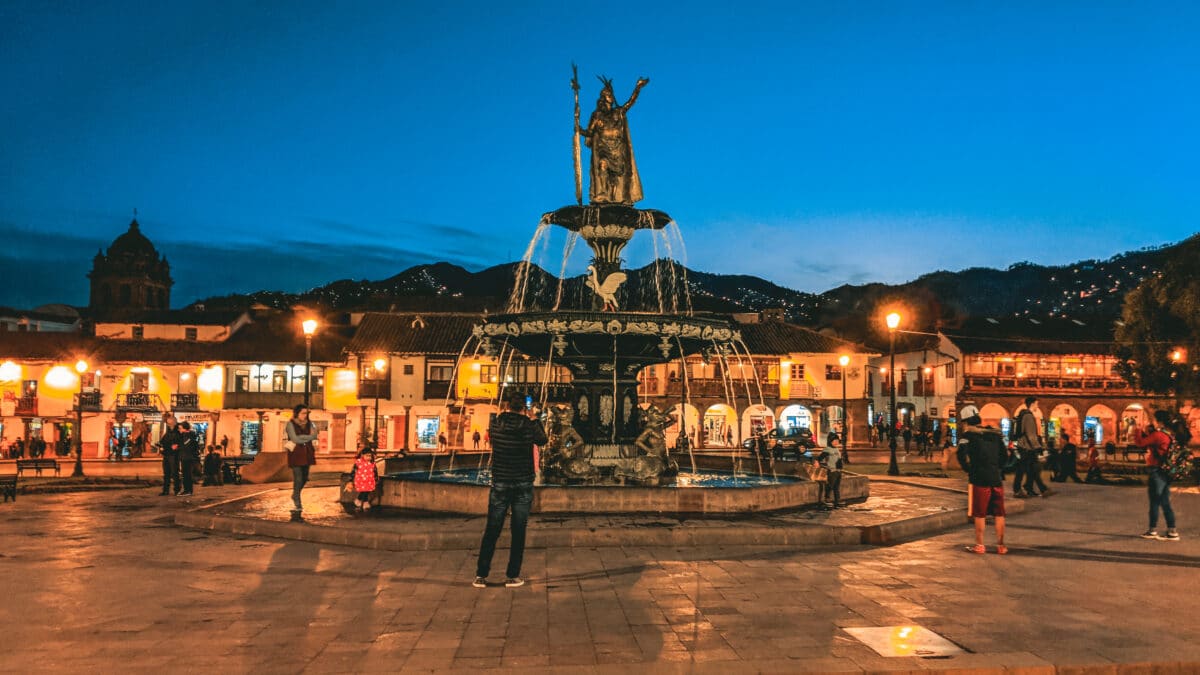
Plaza de Armas
2. Sacsayhuaman
Sacsayhuaman is an ancient Incan complex that’s also complex to pronounce. It’s just a quick 15-20 minute ride from Cusco. Here, the puzzle-like walls would give any modern day mason anxiety. To make them even more amazing is that they fit together so perfectly that you couldn’t fit a razor blade in between some of them.
Still not impressive enough for you? Well, imagine the fact that these walls with their massive stone blocks used to stand a full ten feet higher than they do now.
Sacsayhuaman is open from Saturday to Sunday, from 7 AM to 6 PM.
3. Humantay Lake
If you’re a hiker, a day trip to Humantay Lake is a perfect idea. Glacier-fed and with a turquoise color that is similar to Canada’s immensely popular Moraine Lake, Humantay gives you breathtaking views with more isolation and less people.
The stretch of the Salkantay hiking trail is steep but short, only taking one hour before reaching the lake.
Since it’s a four-drive from Cusco, the cheapest way to experience the lake would be to book a tour.
The only drawback here, as with any tour, is that you’ll have to conform to their schedule. I’ve seen some people complain that they wished for more time at the lake. These tours can cost as little as $25 but you might have to shop around or haggle.
The most convenient way to get there would be to take a private taxi from Cusco. This will cost you about $75-100 to get there and back, which is expensive for Peru, but the taxi will wait for you and you’ll be able to set your own schedule. You’ll also need to pay the $10 park entry fee, which a tour would cover for you.
4. Rainbow Mountain
Vinicunca, more commonly known as Rainbow Mountain, is one of the most popular day trips from Cusco, Peru. If you’ve ever searched for information about Peru, you’ve probably seen pictures of this beautiful site.
This mountain literally looks like a rainbow. Yes, it looks fake but there’s no trickery involved. Due to its location as part of a volcanic chain, it is rich in rare minerals. The minerals are what cause the rainbow coloration. Each color comes from a different mineral that was deposited at a different point in time.
Getting here requires a two-hour drive from Cusco followed by a 3-4 hour hike of about 3.1 miles (5 k). Or you can take a three-and-half-hour drive through Pitumarca and do a steep 0.31 mile (0.5 km) hike (about forty-five minutes) to the vantage point.
Regardless of which route you choose, some high-altitude hiking will be involved. At an elevation of 17,100 feet (5,200 m), Rainbow Mountain is the highest point in Peru that is open for public access. For comparison, Cusco is 11,152 feet (3,399 m) high.
Note that a tour company will probably not let you book through them unless you have already been in Cusco for a few days to acclimate to the altitude.
The weather this high up changes fast so be sure to pack appropriately. When I arrived, it was hot at the start and snowing at the top. The altitude will certainly mess with you as well. I didn’t develop a headache but my gums and teeth hurt.
The hike itself wasn’t difficult, but I wasn’t exactly taking my time. On the bus ride there, two Canadians said that they were going to be the first to the top, thus entering themselves into a race they were unaware of. I beat them by a solid 10 minutes. Take that, strangers I’ll never see again!
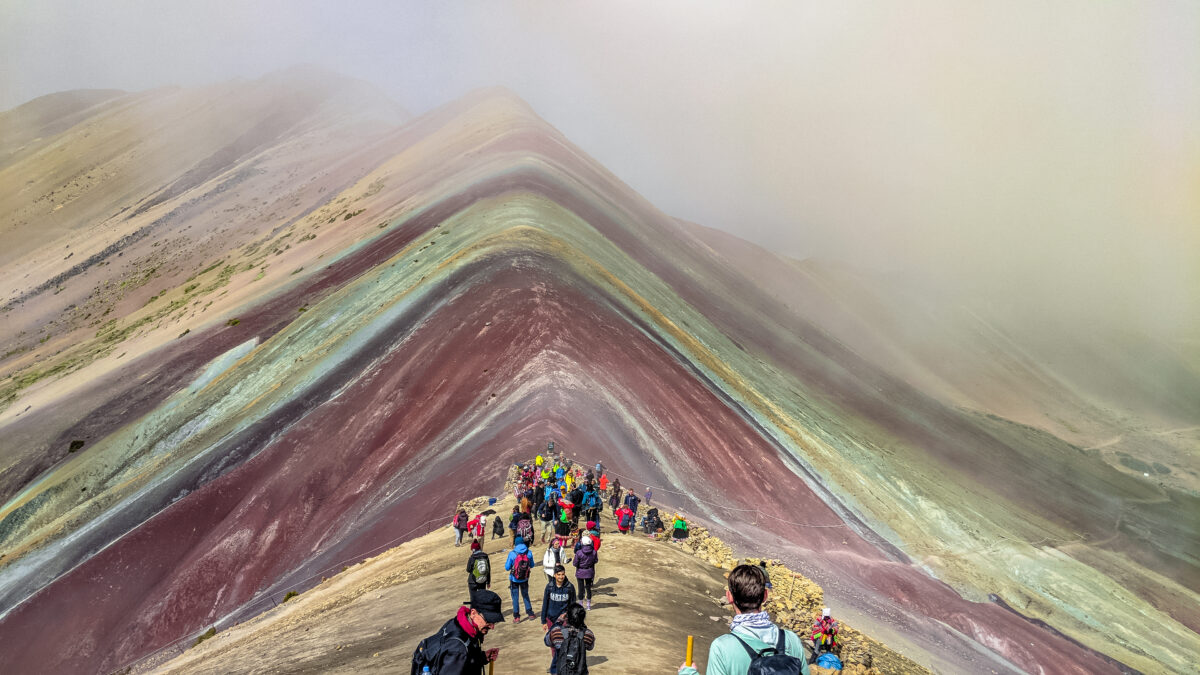
I was almost fogged out but luckily things started to clear at the last minute.
Leave no trace! Remember, you’re a guest here.
The Canadians did beat me back to the bottom though as I was dead last in getting to the bus. When I made it back to the entrance, I found the tour guide impatiently calling my name. Just between you and me, I heard him long before I saw him. I just ignored him.
After reaching the top, my inner eco-warrior kicked into overdrive and I took it upon myself to pick up every piece of trash I saw on the entire trail. EVERY PIECE. And there was a ton of it. Particularly the plastic wrappers from coca leaf candies. Seriously… I know it’s such a terrible inconvenience, but just put the wrappers in your damn pocket.
5. The Red Valley
Do you have a little more time on your hands? Then I’d recommend going just a little further up the trail.
Located a mere 15 minutes beyond Rainbow Mountain (you’ll be able to see part of it), The Red Valley is a beauty in its own right. While Rainbow Mountain has many colors, The Red Valley is painted… you guessed it! Red!
I came to Rainbow Mountain with a tour group and even with my fast ascent I wasn’t able to fit in The Red Valley as I spent too much time sitting at the top and picking up trash. This is part of why I hate tours so much.
So if you’re with a tour, be sure that you’ll have enough time to make it there and back first.
6. Sacred Valley
The Sacred Valley of the Incas, or the Urubamba Valley, is a sizable valley in the Andes of Peru, 12 miles (20 km) north of the Inca capital of Cusco.
In addition to breathtaking views, the Sacred Valley contains several more specific archaeological sites such as Machu Picchu, Moray, Ollantaytambo, and the Maras Salt mines.
It’s easy to forget this fact while you’re driving around the area but should you wish to visit any of these sites, remember that you’re going to be spending plenty of time in the valley proper.
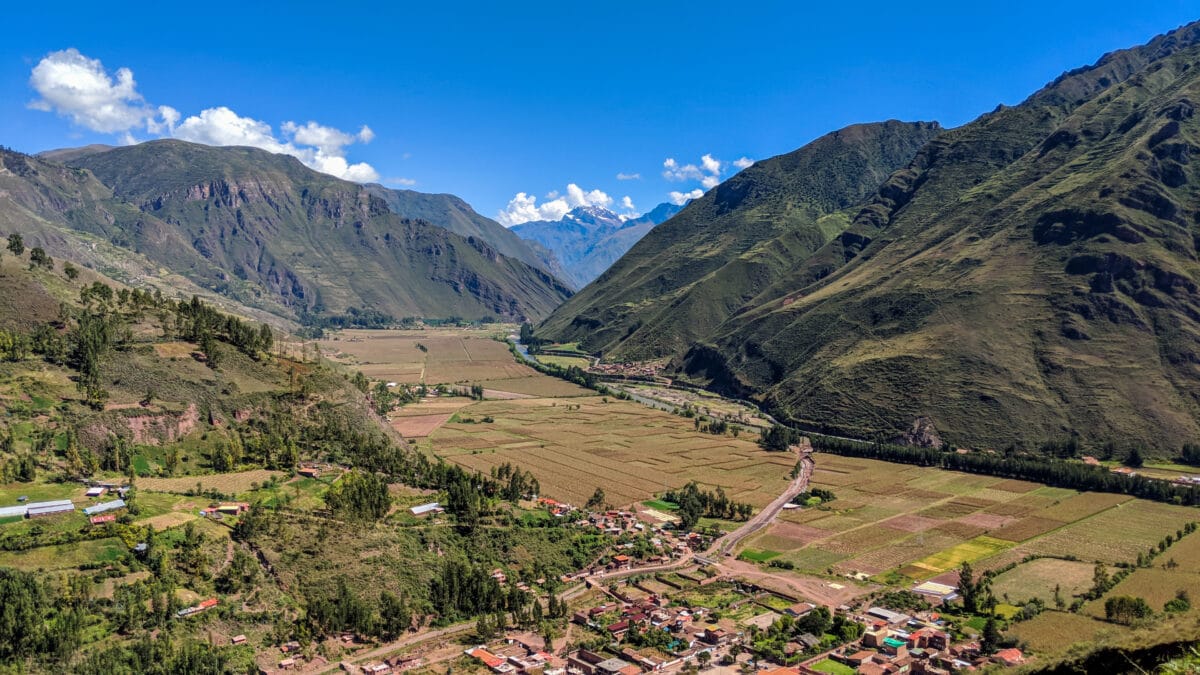
7. Machu Picchu
When you’re looking for things to do in Cusco, this is it. The big one. If you tell someone you’re going to Peru, the first thing that comes to anyone’s mind is Machu Picchu. I knew there was plenty else to see but this was my #1 motivation in deciding to travel to the region.
Largely believed to have been constructed as an estate for the Inca emperor Pachacuti, these ruins are breathtaking in all respects.
As Machu Picchu is a place that needs more than just a little blurb to do it justice, you can find my full write up on the historical site, here.
You can check out my full writeup on Machu Picchu HERE.
8. Ollantaytambo
Like Machu Picchu, I could easily write an entire blog post just on Ollantaytambo. This little village in the Sacred Valley of southern Peru with its cobblestone streets and adobe buildings is a gem.
Set on the Urubamba River and beneath snow-capped mountains, the village is about as traditional as you’re going to find and there is just little enough tourism that it’s not invasive.
The town is best known for the Ollantaytambo ruins of Cerro Bandolista. These are a massive, terraced Incan religious site (often thought to be a fortress) along an entire hillside. It’s here that you’ll find the Sun Temple and the Princess Baths fountain with more ruins hidden above everything and accessible by a short hike.
Seeing the Wall of the Six Monoliths in person will blow your mind in terms of how much work it must have taken to move these gargantuan blocks.
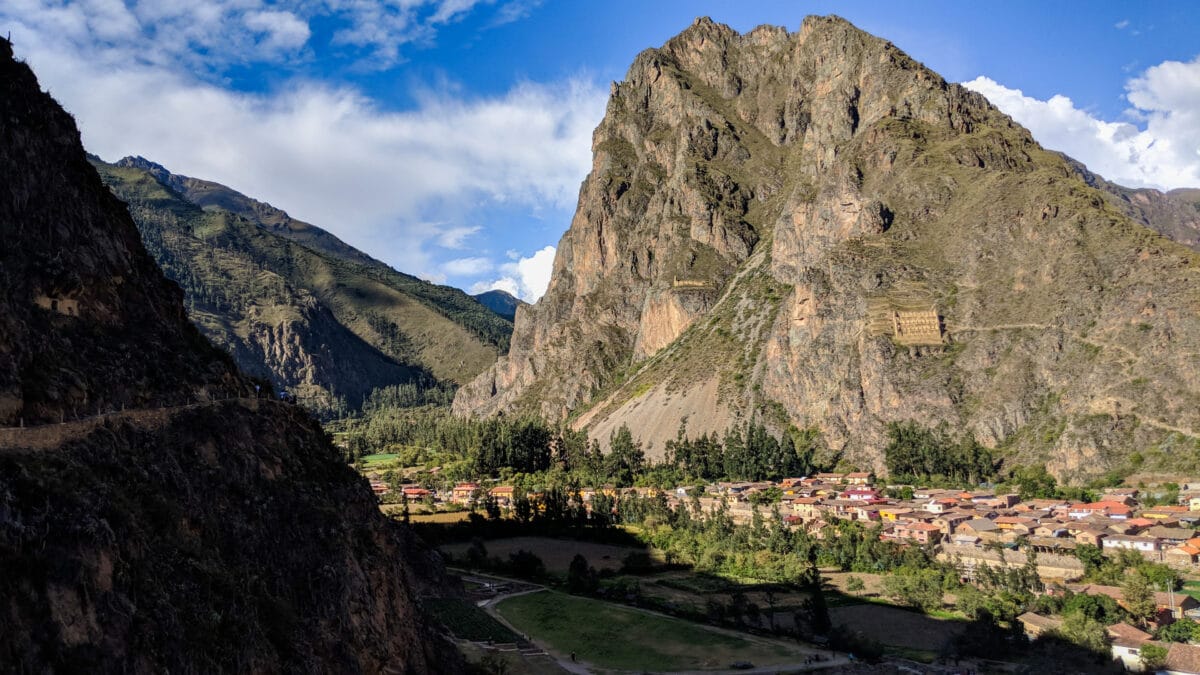
Unfortunately I lost most of my Peru pictures. The missing Ollantaytambo shots are the worst but this was shot in the ruins.
Where to stay:
I only went for a day in conjunction with a Sacred Valley tour but should you so desire, there are cheap hostels located within the village.
My tour was open ended, meaning that while it started in Cusco, it ended in Ollantaytambo. This was to allow people as much time as they wanted to explore the immediate area.
Getting there:
There are two bus routes to reach Ollantaytambo, but the Chincheros route is the only direct one. For this you take a bus from Pavitos Street. It will drop you off at Plaza de Ollantaytambo, after a stop in Urubamba town.
Bus service departs hourly, and operates every day. The trip takes approximately 1 hour and 30 minutes to 2 hours.
The other route requires two separate buses with a taxi ride in between.
If you’d like to continue on to Machu Picchu from Ollantaytambo, there is a train which will take you 1 hour and 50 minutes. There are two train companies that you can choose from: PeruRail and Incarail.
Unfortunately, at the time of writing, there is no train disembarking at Ollantaytambo from Cusco, meaning you can get on and continue to Machu Picchu, but you can’t get off. So no train to Ollantaytambo. Makes perfect sense, right?
Buses back to Cusco are easier as everyone will point you toward the station.
I skipped the bus back and split a taxi to Cusco with two other Americans. This ended up taking almost three times as long as the bus because the car had the the engine of a lawnmower. I don’t think we broke 35mph the entire way. Uphill? I could have walked faster. I’m not joking.
9. Moray
Moray is a site about 31 miles (50 km) northwest of Cusco, Peru. Seated on a plateau just west of the village of Maras, it contains some unusual Inca ruins. And when I say unusual, I mean damn do they look cool!
These ruins consist of multiple terraced circular depressions that start out very large and get smaller the deeper they go. They really look quite cool. Their exact purpose is technically uncertain but my guide told us that it was for farming purposes.
Their depth, design, and special positioning creates a temperature difference of as much as 27° F (15° C) between the top and the bottom with each terrace essentially having its own micro-climate. This would have allowed for different types of crops at each level.
The farming theory is further backed up by different soil types found on each level.
Getting here can be quite fun as I took an ATV to the site from Maras. You even get to ride them through the village streets and alleyways.
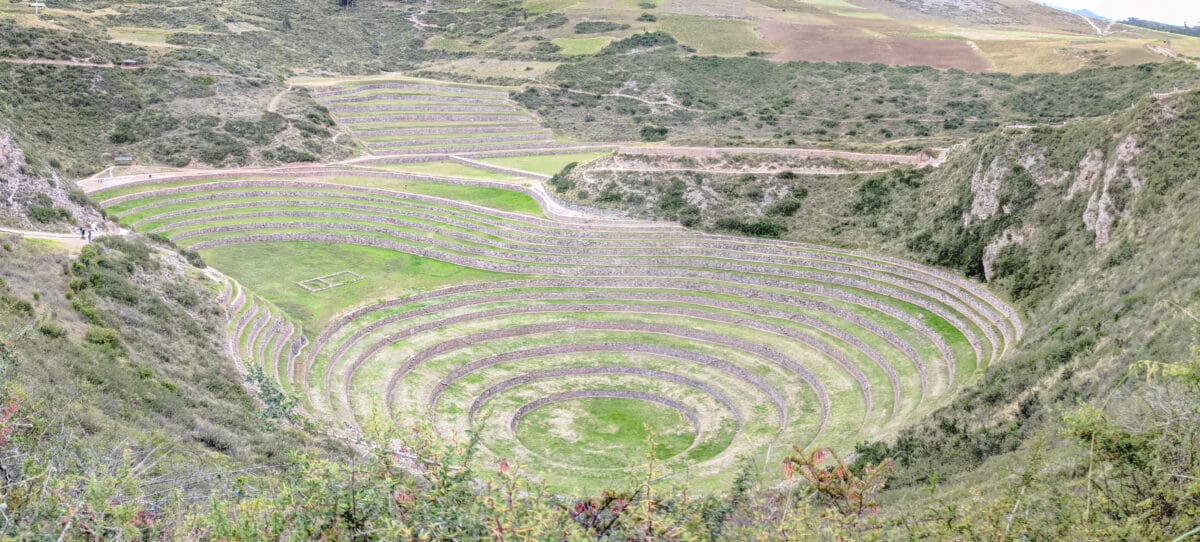
The Moray Terraces
10. Tambomachay
This archaeological site consists of a series of aqueducts, canals and waterfalls that run through the terraced rocks. The function of the site is uncertain but it’s believed that it may have served as a military outpost guarding the approaches to Cusco, as a spa resort for the Incan political elite, or both.
This is a rather small site so don’t worry about keeping it low on your list. I skipped it.
11. Qenko
Another archaeological site, Qenko is one of the largest holy places in the Cusco Region. Many huacas were based on naturally occurring rock formations. It was believed to be a place where sacrifices and mummification took place.
12. Maras Salt Mines
The Maras Salt Mines are another unique set of ruins, both in looks and use.
Since pre-Inca times, the residents of Maras have farmed salt by evaporating salty water from a local subterranean stream.
While the cause of the water’s salinity is unknown, it emerges at a spring where the flow is directed into a complex system of channels. These then allow the water to gradually run down onto the hundreds of ancient terraced ponds.
To this day, salt is still farmed in the same ancient way by members of the community who each have their own designated pond.
When I was there we were allowed to walk along narrow pathways between the ponds. Unfortunately, though it makes sense, as of September 2019, tourists are no longer allowed around the ponds due to contamination.
I wouldn’t let this stop you from visiting as the best view is easily from the top. Nobody from my group walked in very far. I myself only went down a few tiers.
I took a bottle of the water with me after a good friend of mine who is Peruvian told me she did the same thing while there. Her family used it for grilling. Not exactly sure what I planned on doing with it, but it’s still sitting in my refrigerator years later. Hah!
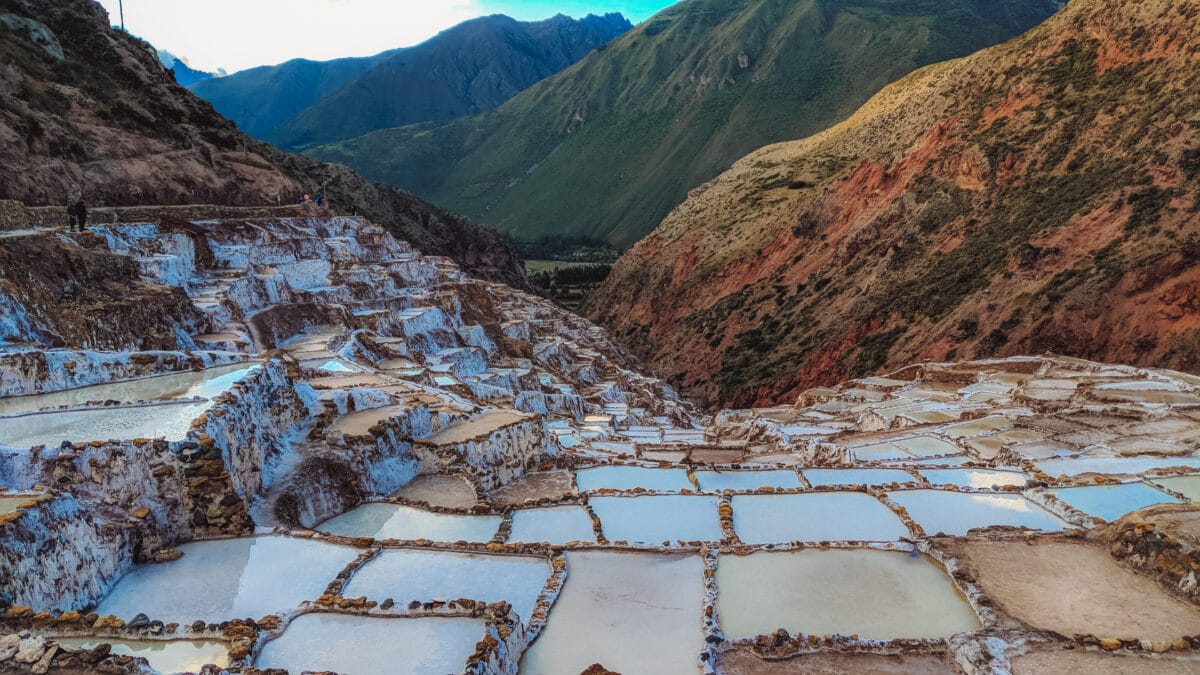
Maras Salt Mines
13. San Pedro Market
About an 8-minute walk south of Plaza de Armas, San Pedro Market is an assault on your senses.
Open all week from 9am-6pm, this huge food market is situated in a massive building that’s one block long and three blocks wide. And you better believe that every square inch of space is put to use. Vendors are packed into every bit of space inside.
You can wander through these stalls for hours and still not notice everything that’s being sold. From foodstuffs to souvenirs, it has it all.
14. Paddy’s Irish Pub
Thirsty? Well, the Irish are everywhere and it’s in Cusco at Paddy’s Irish Pub where you’ll find the highest Irish-owned pub in the world. Measuring in at and at an elevation of 11,156 feet (3,400 m), this pub is a nice break from the more traditional Peruvian fare. The crowds here are more tame than you’ll find in some of the more club-like bars.
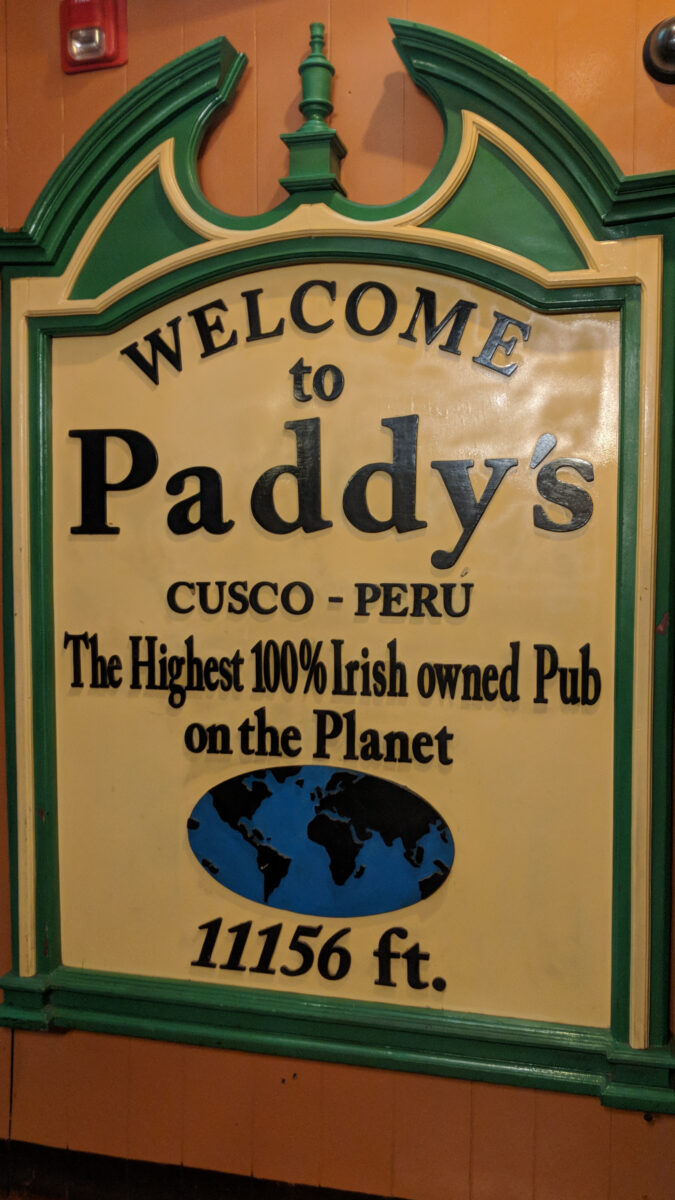
Paddy’s Irish Pub – Cusco, Peru
15. Nazca Lines
The Nazca Lines are a group of massive geoglyphs formed by depressions or shallow incisions made in the ground of the Nazca Desert in southern Peru.
Created between 500 BC and 500 AD by the Nazca people, they were believed, in one theory at least, to have been created to communicate with deities up in the sky.
Far from Cusco and best seen from the air, you’re going to need a full day if you wish to see the Nazca lines.
While they are not in the Cusco area I still feel that these are worth the experience. Granted I’m saying that as someone who didn’t get to see them. I had planned on it but unfortunately things don’t always work out.
16. Paragliding
The views of the Sacred Valley are incredible. So what can be done to make them even better? Perhaps you’d like to try paragliding.
What is paragliding? Paragliding is the activity of gliding through the air, while only attached to a parachute that resembles a canopy. Paragliders descend from high altitudes, like mountains and cliffs.
Being high above affords you spectacular views that you wouldn’t otherwise be able to experience.
If you’re worried, you have little need to be. Paragliding is a safe activity and you will be flying in tandem with a professional instructor the entire time.
Odds and Ends
Where to stay
Being a budget travel guy, I, of course, stayed in a hostel. Do I even need to say this anymore? I stayed at the Inca Wild Hostel. I wanted to find a party hostel. With a word like Wild in the name it has to be fun, right? Wrongggggg! This hostel had no social atmosphere. I was the only American there. Every other guest was from Israel and they were not welcoming to a solo American. No joke.
To date, staying in this hostel was the closest I’ve come to getting in a fight while traveling. Someone decided to take over my locker while I was at Machu Picchu. My lock vanished and everything left in it was dispersed around the room. It was nothing of value, but that’s not the point.
When I called the guy out about it, he got super argumentative and yelled that I had no idea what I was talking about. Yeah, because when the cleaning staff empties things out of a locker they throw everything on top of the locker and under a bed.
Things got heated. Luckily it didn’t escalate further than yelling because I was alone and he had several others taking interest who were with him. One of which looked and sounded like Frankenstein from Monster Squad.
I almost changed hostels twice based on recommendations by other Americans I met, but I was hardly there as it was. Oh well.
So I guess this is more like a where not to stay section?
You won’t be lacking for better hostels though, as there are many all round the center of Cusco.
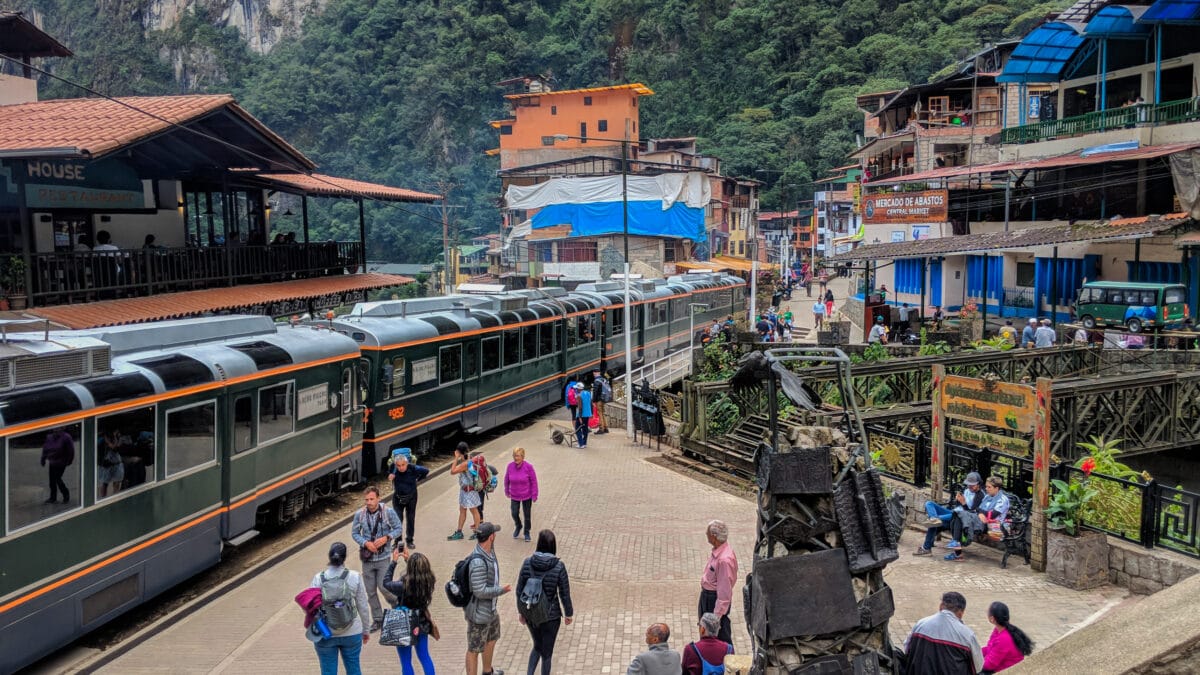
Aguas Calientes, the launching point for a Machu Picchu day trip.
Tickets and Prices
While it can be hit or miss with many places, it certainly holds true for things to do in Cusco, Peru. For this area, I don’t recommend booking full tours online in advance. There are a thousand different tour agencies all around Cusco. By booking locally in the city you almost always save money as opposed to booking online through a major operator. The exception for this would be Machu Picchu as daily tickets are limited and can sell out, especially for climbing either of the flanking mountains.
Should you decide to pass on tours all together in favor of exploring on your own, Ticket Machu Picchu offers various tourist ticket packages that include entrance to most of the sites, including several museums.
This ticket, depending on which package you choose, is valid for a certain number of days during which you can visit every site listed on it. Keep in mind that these are tickets only and do not include any guide services or transportation.
Access to Machu Picchu is also not included in the tickets.
General Tip
You might be thinking, “What are some things to do in Cusco, Peru?” Well, if you’re not careful, it could be nothing.
Now, bear in mind this should be standard travel practice as it can happen anywhere. Cusco just happens to be the first and only place I’ve ever been a victim of it.
Be careful around ATM machines. In fact, try to not use an ATM at all. For most of my life I haven’t owned a credit card. Since I don’t live paycheck to paycheck, I’ve always used a debit/check card. I never needed anything else. Then, Peru punched me in the mouth. No, not literally.
Whenever I use my debit card at an ATM I always give the card reader a firm pull to see if it’s loose. Well, it seems that I missed one because I got my card number stolen.
Even though I had filled out a travel plan that said I’d be in Peru, my bank paid no notice to the fact that someone was buying large credits at an online casino and shopping on Etsy back in the US. I had to notify them.
I eventually got my money back, but not before the bank closed the card and left me stuck with no money.
Can a credit card number still be skimmed? Yes, of course. But if it is, you’re much better protected. Needless to say, I got my first credit card before my next trip.
What do you think? Is Peru on your bucket list? What part are you most interested in seeing? Let me know below!
DID YOU ENJOY THIS ARTICLE? PIN IT!
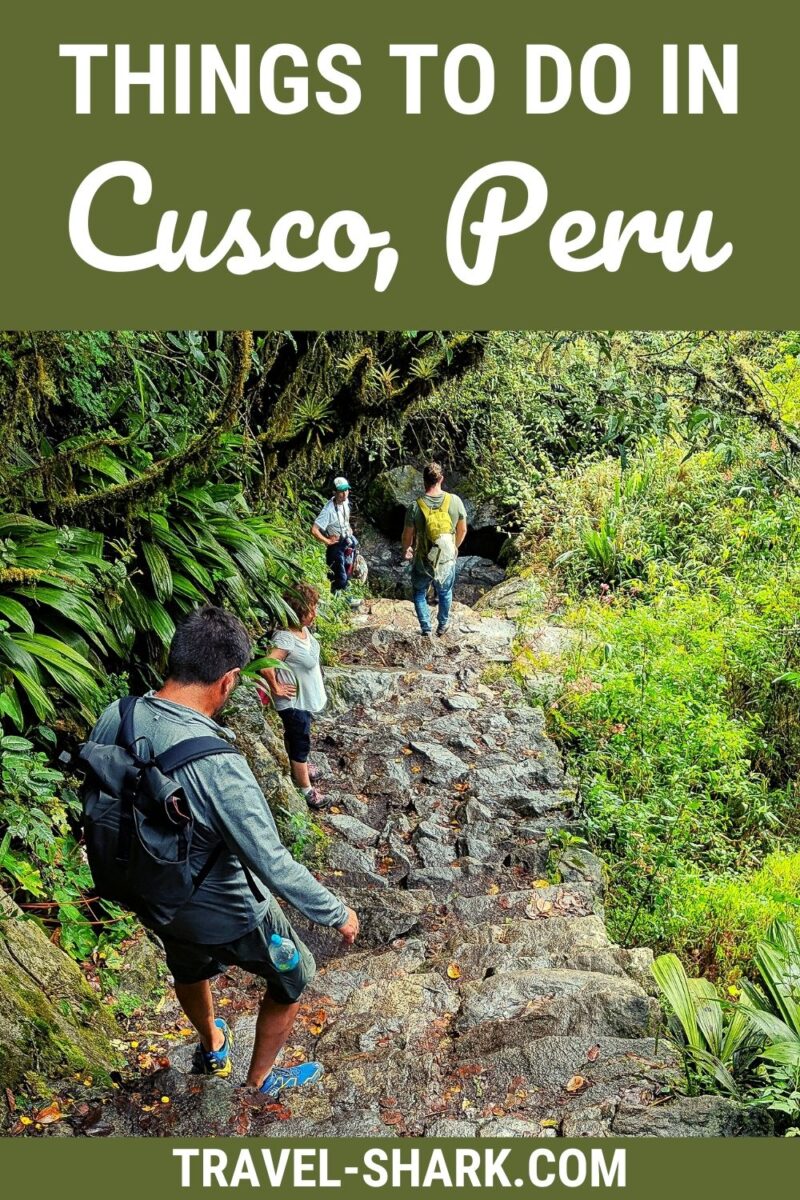

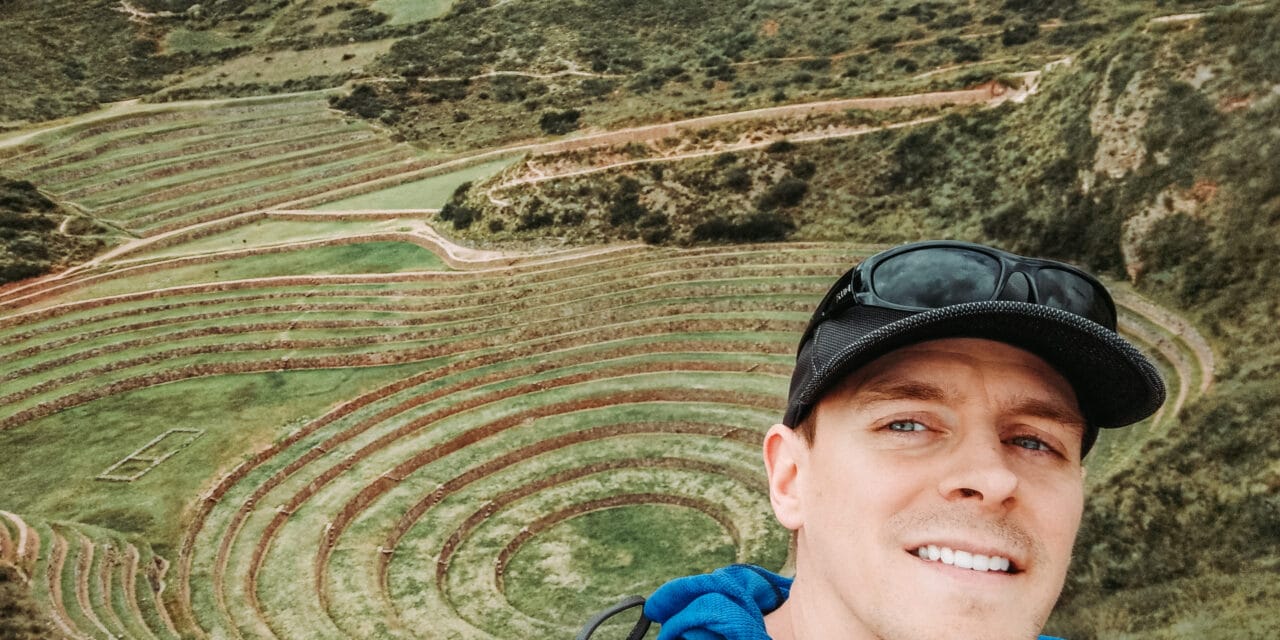
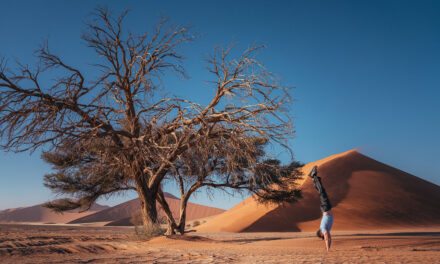
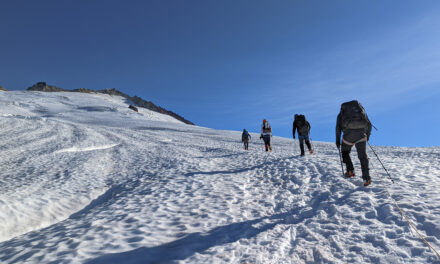
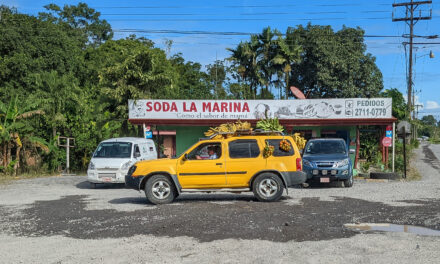
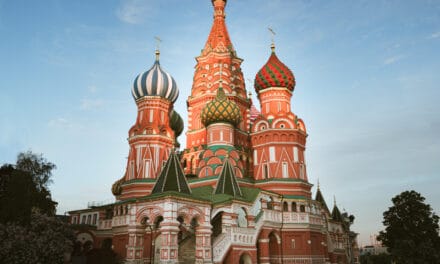

Rainbow mountain looks awesome (minus the part about snow!)
It’s is awesome! It almost looks like it’s man-made. Yea though, I could have done without the cold weather. Was totally not expecting that.
[…] was food and beverages, vendors modeling and selling higher quality clothing than you’d find at a market in Cusco, live music, and a costumed […]